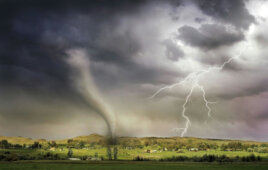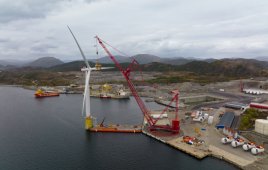By Marcel Schreiner, Global Segment Director, Freudenberg Sealing Technologies’ Energy Sector
The offshore wind energy industry is on the cusp of a significant transformation, fueled by increased demand for clean energy sources, technological advances and improved efficiencies.
Based on projects currently under construction, annual installations of offshore wind turbines are predicted to grow from 6 GW in 2019 to 15 GW in 2024. And the pace is expected to accelerate through the second half of the decade and beyond: A nearly tenfold increase in global capacity is projected by 2030 and total installations could reach nearly 1,000 GW by 2050, according to the International Renewable Energy Agency (IRENA). The bulk of the growth will come from Asia but there also will be significant new capacity in Europe and North America, while initial installations in South America and Oceania are set to begin.
At the same time, the industry continues to transition to hydraulic power and piston-based accumulators.
The rapid growth and evolving technologies are creating new challenges and opportunities throughout the supply chain. Equipment must withstand harsher conditions, be maintenance-free and last longer. All of this puts even greater pressure on sealing and hydraulic systems, and they must be designed and engineered with a comprehensive understanding of the material challenges they will face during installation and use.
The (really) big — and deep — picture
It is not just that there are more installations. Offshore wind turbines also are getting bigger themselves. A lot bigger.
The average capacity of offshore units more than tripled from 1.6 MW in 2000 to 5.5 MW in 2018. In the last two years alone the average size of an offshore turbine has jumped to 10 MW, while new installations planned through 2025 and 2030 are expected to average 12 MW and as much as 15 to 20 MW, respectively, IRENA projects.
The reason for the trend comes down to economies of scale. The incremental cost of increasing the size of a turbine is much less than adding multiple smaller installations with the same combined capacity. This reduces overall costs to help make offshore wind energy more competitive with traditional fossil fuel sources.
Offshore costs already have plummeted by two-thirds over the past five years. This makes them an even more attractive solution than land-based wind farms, which saw a relatively more modest 20% decline in cost during the same period. Strict regulations further limit the future of land sites.
Aquatic wind farms, meanwhile, are moving farther offshore and into deeper water. In Europe, the current average distance from shore is about 60 km. But new units in East Asia are being located as far out as 300 km in waters as deep as 2 km, which requires longer cables and components with tighter tolerances that can withstand even harsher environments.
In addition to being less crowded or publicly intrusive as near-shore installations, turbines located farther offshore tend to produce more energy because they are subjected to higher and more sustained winds.
Loading up with hydraulification
Higher capacity systems require larger turbine blades, which are beginning to top 220 m in diameter in the latest applications. Such large systems also are heavier, thus create higher load pressure — especially as the rotor plate passes by the turbine tower — and put more stress on rotating and transmission components.
Handling higher loads requires continuous pitching, rather than doing so only when conditions change, to find the optimal position and ensure smooth operation. This can be extremely demanding even for short durations, moving three-times per turn and 20 rotations per minute. Wear and tear are compounded over the life of the turbine, with new systems expected to last 25 years or more and several hundred million load cycles — which can push standard materials and components beyond their ability to function.
But failure isn’t an option. If there is even a 5% risk rate among the current 1,000 offshore wind turbines, this could result in 50 non-operational units each year. At projected 2030 levels, the number of affected systems could easily quadruple to about 1,000.
To better manage continuous load fluctuations, manufacturers are increasingly using hydraulic pitching systems in place of electrically actuated ones. Full hydraulification teams a hydraulic cylinder for movement with hydraulic accumulators for load-peak shaving.
This is counter to other industries that are increasingly switching from hydraulic power to electric-driven systems. In the case of wind turbines, however, hydraulic actuation is better suited to handle heavier rotors. Maintaining an electric system would require the use of larger, heavier gears.
Sealing and accumulator solutions
 The huge internal forces generated by large turbines have a significant impact on roller bearings and seals. Structural components of such seals, however, can’t be scaled up accordingly in terms of size and function.
The huge internal forces generated by large turbines have a significant impact on roller bearings and seals. Structural components of such seals, however, can’t be scaled up accordingly in terms of size and function.
But there are other ways to achieve the durability and quality needed to withstand the harsh requirements of large offshore wind turbines. This includes using piston accumulators in place of traditional bladder-style systems.
Piston-based accumulators have a smaller gap at the gasket than elastomer bladders, and thus are less susceptible to permeation. As a result, new installations are almost exclusively using piston systems, which also are increasingly being retrofitted into existing offshore turbines as they are serviced.
Freudenberg Sealing Technologies further limits the chance for leaks by integrating an in-house sealing and accumulator expertise to produce a combined solution. This integrated piston accumulator system for offshore wind application features a high-quality piston seal (SIMKO 300) within a steel piston accumulator — a design that creates optimal tribology for its seals and provides additional protection through the use of high-grade steel, superior surface finishing and high-quality standards throughout the entire assembly.
Offering the perfect synergy of functionality and quality, the combined system also enables greater pressure within the accumulator without increasing the overall size. These offshore accumulators have been designed by adapting long-validated technology that the company supplies for automatic gearboxes in passenger cars and commercial vehicles. It’s the logical evolution of sealing technology in offshore applications.
The proven design allows for a high level of standardization to improve manufacturing efficiencies and reduce costs. But it’s also easy to customize the accumulators for application-specific requirements as needed. The technology is highly transferable.
Lifetime performance requirements
Offshore wind generation is one of the most promising power generation alternatives available today. It’s abundant, environmentally friendly and becoming much more economical.
The biggest challenge for components is to meet strict performance requirements in ultra-harsh conditions, then maintain them over increasingly long lifecycles. Such criteria likely will become even more demanding in the future as installations continue to ramp up and users become more reliant on the technology to meet growing worldwide energy consumption.
It can take five to 10 years to develop, install and complete a new offshore wind farm. This is followed by a more than 25-year life expectancy, which means that systems currently under development likely will still be in service well past 2050.
To that end, Freudenberg puts its products through vigorous testing and validation throughout the development and production processes. The goal isn’t just to survive in today’s environment, it’s to anticipate and exceed future requirements — including once-in-a-century storm events that are becoming much more frequent.
As technology continues to evolve, hydraulification and piston-based accumulators will become more commonplace throughout the offshore wind industry. But supplier expertise and commitment to quality could ultimately decide the winners and losers.
 Marcel Schreiner is Global Segment Director of Freudenberg Sealing Technologies’ Energy Sector. In this role, he oversees a worldwide sales team that is focused on meeting the material and product needs of energy customers working in areas like switchgears, transformers, wind turbines, fuel cells, electrolyzer and battery storage systems. Schreiner earned his BA in electrical engineering from the University of Cooperative Education in Mannheim (Germany) in 2005 and a master’s degree in electrical engineering from the University of Freiburg (Germany) in 2011. He has been employed by Freudenberg Sealing Technologies for 19 years. He specializes in the development of energy innovations like smart seals and long-life main bearing seals for wind applications.
Marcel Schreiner is Global Segment Director of Freudenberg Sealing Technologies’ Energy Sector. In this role, he oversees a worldwide sales team that is focused on meeting the material and product needs of energy customers working in areas like switchgears, transformers, wind turbines, fuel cells, electrolyzer and battery storage systems. Schreiner earned his BA in electrical engineering from the University of Cooperative Education in Mannheim (Germany) in 2005 and a master’s degree in electrical engineering from the University of Freiburg (Germany) in 2011. He has been employed by Freudenberg Sealing Technologies for 19 years. He specializes in the development of energy innovations like smart seals and long-life main bearing seals for wind applications.
Filed Under: Featured





